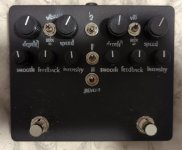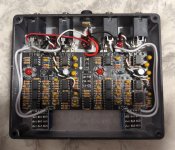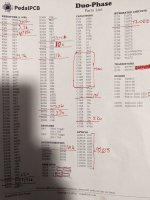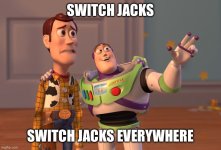DGWVI
Well-known member
- Build Rating
- 5.00 star(s)
Haven't had a chance to record a demo, but I can assure you it does a thing. Audibly, even.
I'll try to get a video tomorrow before I leave, or when I get back in a couple days.
I included my build doc notes for the things I changed.
Changes apply to both sides



As we're all aware, this is the best phaser. Build one, get swooshy
I'm most likely gonna be building another one of these when I return, but I'm gonna try the UniVibe Values for the caps in the phase stages
I'll try to get a video tomorrow before I leave, or when I get back in a couple days.
I included my build doc notes for the things I changed.
Changes apply to both sides
- All the 3.9k, 39k, and 390k were swapped to 3.3, 33, and 330k respectively simply because I didn't have those exact values in my stash (actually, just didn't wanna dig for my seldom used parts values bin
)
- R3 increased to up the input impedance a smidge
- R7 reduced to 4.7k for more feedback. I felt this was a good value without it running off into full self-oscillation
- R28 and R29 changed to closest values I had on hand
- R30 has one leg lifted and attached to an SPDT to defeat the dry blend for Vibe tones
- R34 lowered to 100r to essentially stop the sweep of the LFO
- R35 lowered to better accommodate the raised value of the rate pot
- R37 raised to 1k as I didn't have any 560r
- C6-C11 raised to 10n for a bit more fat in the wet signal
- C13 raised to 1n to take a bit more of the high end off when the feedback pot is maxed, and/ or when the speed pots are at their upper reaches
- Rate pot increased to 1MA to go from slightly slower than stock speeds up to pseudo ring Mod tones in conjunction with R34 & R35. I used an audio taper to make it easier to dial in the midrange speeds
- C18 increased because I have a lot more 22u tants on hand than 10u, and the value wasn't critical here
- Both Trimpots have been made external. I've labelled the 10k Smooth, and the 1k Intensity
- LDRs are 9203
- LEDs are diffused Red Ultrabrights
- IC6a/b are TL022 to help mitigate any ticking that might occur
- Toggles added as a dry kill to R30 for vibe-like tones. With the asymmetrical waveshape of the LFO, this does some cool detuning stuff
- Another toggle added to allow both outputs to be used independently. Though I may make this a full series/ parallel switch



As we're all aware, this is the best phaser. Build one, get swooshy
I'm most likely gonna be building another one of these when I return, but I'm gonna try the UniVibe Values for the caps in the phase stages
Last edited:





